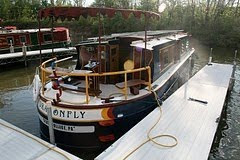 |
| Evidence of careful urban planning: A personal-szied backyard canal, property of the Colonial Governor of Virginia. (Cap sez: "I want one!") |
Yesterday we grabbed a rental car and burned some fossil fuel running up to Colonial Williamsburg, which the crew has long yearned to visit.
If you're not familiar with the place, it's a living history museum that lets you step back into the 1700s. The houses, the shops, and the public buildings--armory, courthouse, jail, several churches--have been restored or reconstructed using "historically correct materials." (I DID notice, however, that the antique iron street lamps use compact fluorescent bulbs).
 |
| A horse at a walk goes 4 mph. So does SlowBoat. Strictly speaking, both are solar powered. |
The place is staffed by a whole lot of well-trained actors in capes, mobcaps, and knee-breeches, who wish you "Good Day!", invite you into their "homes," and inquire which of the colonies you hail from.
You can ask the shoemaker about the latest fashion trend in Pilgrim-style buckle shoes, or ask the cook for the secret to the golden biscuits she's taking from a Dutch oven on a stone hearth.
 |
| Cap wants a locktender's cottage This would do the job nicely! |
I had to laugh at the ways boat life resembles Colonial life for most citizens other than the Governor (who lived in splendor): Clothing with visible dirt stains. Messy hair. Small rooms, furnished with few possessions.
Dishes washed carefully in a small pan of water. Meals planned to use up leftovers and avoid wasting food. And life planned around daylight hours, because fuel is expensive and nighttime illumination is not very bright anyway.
 |
| When it takes effort to get water, you conserve |
After some consideration I didn't purchase the wooden barrels and stoneware crocks I fancied--too heavy, too fragile, too hard to secure safely in high seas. And no way am I boating in a gingham dress and sunbonnet or a waxed-canvas cape. I like my high-tech parka and polarfleece.
 |
| Real Colonial recycling would send slop to the hogs, not the landfill |
True, our Stickley settle in the salon is not "period appropriate," and canal boaters in the 1800s likely had an oilcloth on the floor, not a Turkish rug. On the other hand, we do have what seems like Colonial-era internet access . . . or possibly even slower.
It's driving me a little crazy. Can I help it if I want the best of both worlds?





You know, Bill could start a very cool trend. Instead of Koi ponds, suburban (or urban) backyard canals.
ReplyDeleteWe've been joking all along one goal of the trip is to "boost interest in canal boating in America" (After all, canal boating is SO popular in England officials are fixing up old derelict canals, and there are waiting lines on weekends to go through locks). Your proposal is a logical extension of that plan. Venture capital, anyone?
ReplyDelete